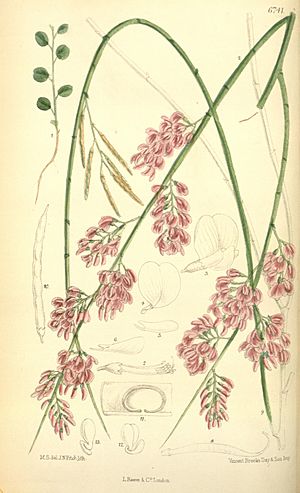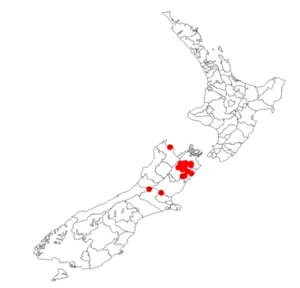Carmichaelia carmichaeliae facts for kids
Quick facts for kids Carmichaelia carmichaeliae |
|
|---|---|
 |
|
| Conservation status | |
 Nationally Critical (NZ TCS) |
|
| Scientific classification | |
| Kingdom: | |
| (unranked): | |
| (unranked): | |
| (unranked): | |
| Order: | |
| Family: | |
| Genus: | |
| Species: |
C. carmichaeliae
|
| Binomial name | |
| Carmichaelia carmichaeliae (Hook.f.) Heenan
|
|
 |
|
| Occurrence data from AVH | |
| Synonyms | |
|
Notospartium carmichaeliae Hook.f. |
|
Carmichaelia carmichaeliae is a special type of plant called a legume. It belongs to the Fabaceae family, which is also known as the pea family. This unique plant is found only in the South Island of New Zealand. Sadly, it is in big trouble! Experts have classified it as "Nationally Critical," meaning it's very close to disappearing forever.
Contents
What is Carmichaelia carmichaeliae?
This plant is a member of the Carmichaelia genus, which includes many native New Zealand plants. It is a type of shrub that can grow to be about 1 to 2 meters (3 to 6 feet) tall. Like many legumes, it has small leaves or sometimes no leaves at all. Its stems are often flat and green, helping the plant make its own food.
Flowers and Seeds
Carmichaelia carmichaeliae produces small, pretty flowers. These flowers are usually purple or pinkish. They grow in clusters along the stems. After the flowers bloom, they form small seed pods. These pods are typical of the pea family. They contain the plant's seeds, which are important for new plants to grow.
Why is it a Legume?
Legumes are a big group of plants. They are known for their special seed pods. These pods split open when ripe. Another cool thing about legumes is their roots. They have tiny bumps called nodules. These nodules help the plant take nitrogen from the air. Nitrogen is a very important nutrient for plants to grow.
Where Does This Plant Live?
Carmichaelia carmichaeliae is endemic to New Zealand. This means it is found naturally nowhere else in the world. Specifically, it grows only in the South Island. It prefers certain types of habitats. You might find it in dry, open areas. It often grows along riverbanks or in rocky places. These areas can be quite harsh, but the plant is adapted to them.
New Zealand's Unique Plants
New Zealand is famous for its unique plants and animals. Many species there are found nowhere else. This is because New Zealand has been separated from other landmasses for millions of years. This long isolation allowed its plants to evolve in special ways. Carmichaelia carmichaeliae is a great example of this unique biodiversity.
Why is Carmichaelia carmichaeliae in Danger?
This plant is classified as "Nationally Critical" under the New Zealand Threat Classification System. This is the highest level of threat. It means the plant is at a very high risk of becoming extinct in the wild.
Threats to its Survival
Several things put Carmichaelia carmichaeliae in danger. One major threat is habitat loss. Its natural homes are often cleared for farming or building. Another problem is invasive species. These are plants or animals brought from other countries. They can outcompete native plants or eat them. For example, introduced animals like deer or goats might graze on the plants. Also, changes in climate can affect its growth.
How Can We Help?
Protecting plants like Carmichaelia carmichaeliae is very important. When a species goes extinct, it's gone forever. It also affects the balance of nature.
Conservation Efforts
Many people and groups are working to save this plant. They might do things like:
- Protecting its habitat: Setting aside special areas where the plant can grow safely.
- Controlling pests: Removing invasive plants or animals that harm it.
- Growing new plants: Collecting seeds and growing young plants in nurseries. These plants can then be planted back into safe areas.
- Research: Studying the plant to understand its needs better. This helps experts know the best ways to protect it.
By learning about unique plants like Carmichaelia carmichaeliae, we can all help protect the amazing natural world around us.

